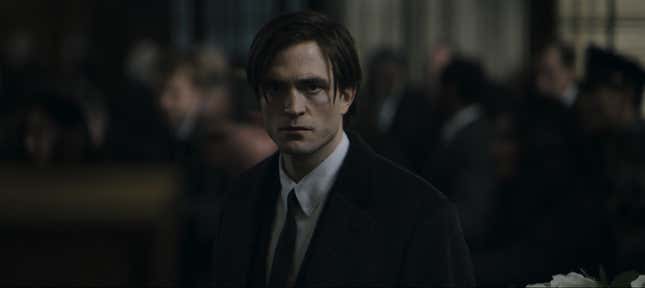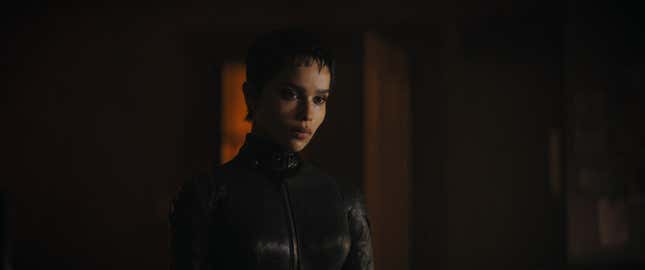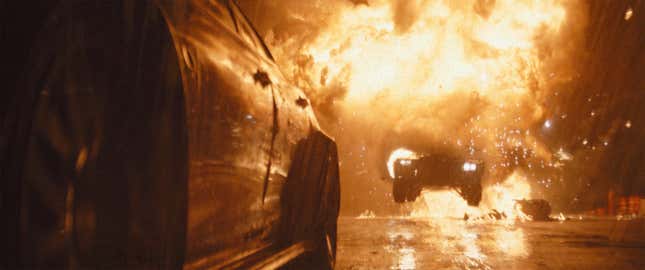
Ever since Robert Pattinson was cast as the new Bruce Wayne for Matt Reeves’ The Batman, I (half-jokingly) wondered if the film would bear any resemblance to Pattinson’s previous brooding billionaire movie, David Cronenberg’s Cosmopolis. There are many surface similarities between Eric Packer (Pattinson’s detestable protagonist in that 2012 film) and Bruce Wayne: Both are obsessed with maintaining peak physical standards, both like to canvas decaying cities in an expensive signature vehicle, and both have way too much money for their own good. But Cosmopolis isn’t a superhero film so much as an absurdist, anti-capitalist literary adaptation, casting its goals (and its audience) pretty far from The Batman’s.
Yet, interestingly, The Batman does have a climactic scene that puts Batman in a similar predicament to Packer’s at the end of Cosmopolis, in which a loquacious madman confronts him with the notion that his wealth and status have contributed to the decay around him. As the Riddler (Paul Dano) taunts the Batman with his soliloquy on Bruce Wayne’s privilege, it’s easy to imagine a Batman film that could go to the same places Cosmopolis does in revealing the hollowness of billionaire antics. In the end, The Batman isn’t that film—not even close—but it still flirts with a deconstruction of Bruce Wayne, a concept that in 2022 feels more vital and necessary than ever.
Over the years, we’ve gotten a lot of Batman movies, and each time we get a new one, the filmmakers have to change something about the Caped Crusader to keep him fresh. Reeves’ take on the character tries to set itself apart from past portrayals by nodding heavily toward neo-noir and detective stories. It also reinvents Bruce Wayne by portraying him as a perpetually distraught, grungy recluse instead of the philanthropist playboy of prior films. But one aspect about The Batman that isn’t new—and that keeps the 2022 film of apiece with every other film incarnation of the character—is his fortune.
A legacy of wealth and privilege
Ever since Batman was introduced in 1939’s Detective Comics #27, he’s been established as a wealthy business magnate. In nearly every canonical depiction, Bruce Wayne is the heir of the Wayne family’s multibillion-dollar corporation, its holding companies, and the Waynes’ chunks of prime Gotham City real estate. All of Batman’s gadgets come from the seemingly endless resources at Bruce Wayne’s disposal, and all of his skills are the result of Wayne’s endless free time. The DC universe is full of heroes who can fly, deadlift tanks, and break the sound barrier with nothing but their bodies, yet Batman remains the most popular DC hero by far because he has the superpower that every person seems to want: vast wealth combined with zero obligations.

Batman’s money is as integral to the character as his pointy-eared mask and cowl, so very few screen adaptations have tried to alter or omit this part about him. But while Batman’s wealth may be an unchanging factor in the movies, in real life, the public’s conception of, and relationship to, wealth is changing constantly. There have long been debates about what separates the upper class from the middle class, and what constitutes a “self-made” fortune.
In the years since the 2008 financial crisis and the 2011 Occupy Wall Street movement, a growing number of Americans have identified income inequality as a central political issue, and in the wake of the COVID-19 pandemic, more people have begun to question the societal role and responsibilities of billionaires. If you’re a civic-minded individual, chances are you already have some sort of stance on the question of whether billionaires should exist or not, because that conversation has become ubiquitous.
Our collective suspicion of real-life billionaires hasn’t exactly translated to distrust of fictional ones, seeing how Batman and fellow billionaire supe Iron Man remain flagship heroes at their respective labels. But in some small ways, these heroes have to adapt to the climate around them—something Batman has always done.
A billionaire boys’ club
Of course, he’s far from the only rich superhero. There’s the aforementioned Iron Man, Green Arrow, the Blue Beetle II, and more. If you go back before the first comic book superheroes were even created, rich masked adventurers were a staple of pulp adventure fiction. Of these, Zorro was a direct inspiration for Batman. Zorro’s progenitor was the Scarlet Pimpernel, a creation of Hungarian baroness Emma Orczy who fought on behalf of the French aristocracy in stories set during the French Revolution. The trope of the wealthy masked vigilante has roots in this very old, very aristocratic fantasy that the rich and powerful are ultimately good-natured protectors of society. Our contemporary infatuation with Batman and Iron Man is just the latest iteration of this phenomenon.
Batman made his screen debut with the 1943 Batman film serials. Produced during the height of World War II—when the U.S. government had more command over the country’s private industries than ever before—these early serials portrayed Batman as an agent of the government, since the Motion Picture Production Code prohibited heroic depictions of vigilantism at the time. But even with the limitations of censorship and a shoestring budget, the serials made sure to include Bruce Wayne’s palatial manor and his loyal butler, Alfred. These serials paved the way for the mainstream embrace of the 1960s Batman show, and from that point on, Batman’s riches were a given in screen adaptions.

The live-action TV and film productions of the ’60s, ’80s, and ’90s all painted Wayne’s fortune with a glossy sense of diversion. Out of these works, only the Tim Burton films gestured towards a criticism of Wayne’s wealth, by envisaging Wayne Manor as a moribund, isolating fortress. Given the enthusiastically pro-capitalist Cold War politics informing popular American media at that time, the lack of critical insight offered by the Adam West, Burton, and Schumacher eras is hardly surprising. And later, Christopher Nolan’s Dark Knight trilogy did little to advance the discourse in this area, even as it followed in the footsteps of the grittier Batman comics of the late ’80s, which took a more subversive view of Batman’s power as a private individual.
Moving away from metaphorical power dynamics
The last installment in Nolan’s trilogy, The Dark Knight Rises, was the first Batman film to be made in wake of the global recession, and it’s also the first Batman film to pay lip-service to the idea that massive private wealth is inherently harmful. The first half of the movie is built around stripping Bruce Wayne (Christian Bale) of his assets and gadgets, forcing him into a situation where he must learn to be heroic without the safety net of affluence while his company and his Batcave war chest are being used against the people of Gotham. (This narrative move would be echoed to an extent by Iron Man 3 a year later.)
Batman’s new rivals in the film, Catwoman (Anne Hathaway) and Bane (Tom Hardy), speak in half-baked, Occupy-esque slogans until their unrelated and banal narrative functions are fulfilled in the third act. By the end of The Dark Knight Rises, Bruce Wayne’s status as an all-powerful, capitalist savior is unchallenged, and the status quo for the regular people of Gotham is reasserted. The Nolan Batman films quite effectively used Gotham to reflect on post-9/11 fears and the West’s potentially corrupting desire for security, but the movies had nothing substantive to say about class conflict.
Given what came before it, it’s clear that The Batman is the film to address the Waynes’ wealth hoarding most directly. The bar was already low, and any new Batman film would have to raise it because, in the decade since the close of Nolan’s trilogy, there’s been a deluge of commentary pointing out how Batman’s chosen method of cleaning up the city might not be the most helpful.
The argument goes: If Batman has enough money to fight crime with Batarangs, then he must have enough money to use philanthropy to achieve the same results, right? Well, The Batman circumvents this argument by spinning most of its plot around Thomas Wayne’s failed $1 billion city renewal fund. Long before Pattinson’s Wayne became Batman, the Waynes already tried to throw money at Gotham’s problems, and all it resulted in was greater mass of corruption, and less resources for Gotham’s poor and orphaned, giving rise to the Riddler. The “Renewal is a lie” refrain highlights the failure of Gotham’s wealthy and powerful to effect change through traditional means.
Reeves’ Bruce Wayne wrestles with his inheritance
Straight off the bat (pun unintended), The Batman puts Bruce Wayne in an ironic position. Having witnessed the ineffectiveness of the renewal fund to repair Gotham, Bruce has become alienated from his inheritance and the Wayne family finances. “I don’t care about that. Any of that,” he says when Alfred (Andy Serkis) tries to convince him to meet with some Wayne Enterprises accountants. As the film progresses, Bruce learns some of the ways his family’s wealth was the source of Gotham’s dysfunction. The renewal fund ended up funding Falcone’s criminal empire, and his father Thomas Wayne participated in the murder of a journalist.

Naturally, The Batman holds back on some of its scrutiny of the Wayne family when it could have gone deeper. Thomas Wayne’s irresponsibility in hiring a known mob boss to intimidate the press gets handwaved as a simple mistake made by a “good man” (even after 2019’s Joker already went full bore and eviscerated the man to the tune of $1 billion in box office totals). And the film never tries to ask how the Waynes acquired and maintained so much money while the city of Gotham stayed so poor.
For all the film’s concerns about political corruption, it still pushes the naive view that a few good cops are what is needed to rout corruption in the GCPD rather than concrete policy change and a reorientation of the city budget. Like The Dark Knight Rises, The Batman trots out Catwoman to make some statements about economic inequality and “white, privileged assholes” that don’t get backed up by any dramatization or character arc. And the Riddler’s sound motivations and grounded criticisms of structural inequity in Gotham get sidelined late in the third act to make him yet another supervillain with a vague desire for destruction and chaos.
Suffice it to say that The Batman is no Cosmopolis, even if Pattinson is using the same accent sometimes. A thorough deconstruction of capitalism in the form of superhero movie probably isn’t possible, as much because such a thing would never be bankrolled by a major studio as the fact that it was made to generate hundreds of millions of dollars for its corporate parent. Even so, the gestures The Batman makes in that direction speak to some of the current cultural anxieties about wealth and inequality, at least slightly better than the privileged Bruce Waynes of the past.